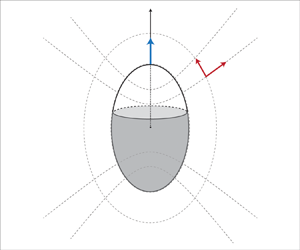Published online by Cambridge University Press: 10 May 2024

Shear-thinning viscosity is a non-Newtonian behaviour that active particles often encounter in biological fluids such as blood and mucus. The fundamental question of how this ubiquitous non-Newtonian rheology affects the propulsion of active particles has attracted substantial interest. In particular, spherical Janus particles driven by self-diffusiophoresis, a major physico-chemical propulsion mechanism of synthetic active particles, were shown to always swim slower in a shear-thinning fluid than in a Newtonian fluid. In this work, we move beyond the spherical limit to examine the effect of particle eccentricity on self-diffusiophoretic propulsion in a shear-thinning fluid. We use a combination of asymptotic analysis and numerical simulations to show that shear-thinning rheology can enhance self-diffusiophoretic propulsion of a spheroidal particle, in stark contrast to previous findings for the spherical case. A systematic characterization of the dependence of the propulsion speed on the particle's active surface coverage has also uncovered an intriguing feature associated with the propulsion speeds of a pair of complementarily coated particles not previously reported. Symmetry arguments are presented to elucidate how this new feature emerges as a combined effect of anisotropy of the spheroidal geometry and nonlinearity in fluid rheology.
These authors contribute equally to this work.